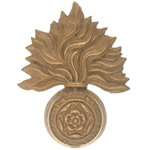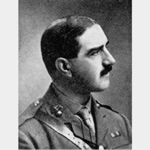Commemorated: | |||
| 1. Memorial: | Royal Irish Rifles Graveyard Laventie | ||
| 2. Book: | The (1921) Masonic Roll of Honour 1914-1918 | Pg.132 | |
| 3. Memorial: | The (1940) Scroll - WW1 Roll of Honour | 1A GQS | |
Awards & Titles: | |||
Early Life :
Henry, known as Harry, Pulman was born in Marylebone. Harry was the younger son of George Frederick Pulman; husband of Rosa Pulman, of Fryth, Great Berkhamstead. Member of Westminster City Council. The Pulmans are an old West of England family. The portrait photo is taken from the Marylebone Mercury 20th March, 1915.Education & Career :
Educated at Archbishop Tenison's School and at Guines', Calais, France, he joined the family business of Mssrs G Pulman & Sons, becoming MD.
He was a member of the Stationers' Company.
Service Life:
Campaigns:
- The First World War 1914-1918, World-wide.
| Unit / Ship / Est.: 3rd Battalion London Regiment (Royal Fusiliers) |
1/3rd (City of London) Battalion (Royal Fusiliers) August 1914 : at Edward Street in Hampstead Road. Part of 1st London Brigade, 1st London Division. Moved on mobilisation to guarding the Basingstoke-Eastleigh railway. 4 September 1914 : sailed with Brigade from Southampton to Malta, arriving Valetta 14 September. 2 January 1915 : left Malta, arrived at Marseilles on 6 January. 10 February 1915 : joined the Gharwal Brigade in 7th (Meerut) Division. 17 February 1915 : transferred to Dehra Dun Brigade in same Division. 4 November 1915 : transferred to 139th Brigade in 46th (North Midland) Division. 16 November 1915 : transferred to 142nd Brigade in 47th (2nd London) Division. 9 February 1916 : transferred to 167th Brigade in 56th (London) Division. 3 January 1918 : transferred to 173rd Brigade in 58th (2/1st London) Division, absorbed the disbanded 2/3rd Bn and renamed 3rd Bn. |
| Action : The Battle of Neuve Chapelle and subsidiary actions |
Following a winter in the trenches the BEF was prepared to take the offensive against the Germans. The location was Neuve Chapelle, a small village in the front line below Aubers Ridge near Lille. Aubers Ridge was a low but significant hill and the intention at Neuve Chappell was to punch through the German front line, occupy the ridge and exploit with cavalry. It was a battle fought by two Corps of the BEF, the Indian Corps and IV Corps both largely consisting of regular battalions. It was to be preceded by the most violent artillery barrage of the war to date. Unfortunately in what was to be the start of the 'learning curve' for the BEF the artillery barrage, whilst violent, failed in some parts ? a failure that was to be costly and which delayed the assault and allowed the Germans to recover. Whilst the men were exceptionally brave they became bogged down as German machine guns and artillery stopped the momentum of the assault and by the end of the first day (10th March 1915) they were digging in. The following day the assault was repeated with fresh battalions but with no success. By the 12th March the Germans had recovered their poise, had brought in reserves and were ready to counter attack.
Neuve Chapelle (10-12 March 1915) was the first planned offensive battle by the BEF in France and achieved limited tactical success but not the expected breakthrough. It highlighted the problem of delay in execution that allowed the defending Germans to regroup, often consequent on small incidents and errors. Having stabilised the situation following the German sweep into France and the counter attack that eventually established static trench warfare on the western front, there was significant pressure on Britain to take a share of the burden from the French (who had without question had born the brunt of the fighting). Although the battle was effectively over by 12th March, the official battle nomenclature included actions in other sectors up to 22 April 1915 including the significant actions at St Eloi and at Hill 60 (Ypres).
Detail :
PULMAN, Henry Robert, Captain, 1/3 London Regiment (Royal Fusiliers)
Following a winter in the trenches the BEF was prepared to take the offensive against the Germans. The location was Neuve Chapelle, a small village in the front line below Aubers Ridge near Lille. Aubers Ridge was a low but significant hill and the intention at Neuve Chappell was to punch through the German front line, occupy the ridge and exploit with cavalry. It was a battle fought by two Corps of the BEF, the Indian Corps and IV Corps both largely consisting of regular battalions. It was to be preceded by the most violent artillery barrage of the war to date.
Unfortunately in what was to be the start of the learning curve for the BEF the artillery barrage, whilst violent, failed in some parts a failure that was to be costly and which delayed the assault and allowed the Germans to recover. Whilst the men were exceptionally brave they became bogged down as German machine guns and artillery stopped the momentum of the assault and by the end of the first day (10th March 1915) they were digging in.
The following day the assault was repeated with fresh battalions but with no success. By the 12th March the Germans had recovered their poise, had brought in reserves and were ready to counter attack. An account indicated the action involving A Company of 1/3 Londons. Their orders were to clear the trench after the Leicestershire Regiment had charged, if the charge was successful. They moved up to headquarters near Neuve Chapelle, where they dug themselves in to the left of Port Arthur on the La Bassee road.
After the bombardment they moved up to the second line of breastworks and there awaited orders. These came at nine, and they moved up to the first line to pick up extra ammunition for the troops already gone forward. The orders were for them to attack the German trench on their right front in which the Germans had barricaded themselves and were doing a lot of damage by sniping.
Captain Pulman and Lieutenant Mathieson and Lieutenant Stephens were killed. Captain E. V. Noel was wounded in the advance. The company was rallied by Lieutenant J. T. Reeves, the only officer left, and late in the evening they joined up with D Company.
Henry (Harry) PULMAN appears several times in the account of Captain Arthur AGIUS MC of the 1/3 London regiment, quoted by Lyn MacDonald in her book '1915-The Loss of Innocence' On Page 44 the 1/3 Londons arrived in Marseilles and Arthur Agius went off with Harry Pulman, Cyril Crichton and Harold Moore to the Hotel Bristol and dined sumptuously When the battalion arrived in Northern France Harry Pulman and Arthur Agius had struck lucky in the matter of billets. The old lady in the farm where they lodged was unusually welcoming, fussing over them like a mother and feeding them like princes... (P.57)
At the celebration of Cpt Noel's birthday There were speeches from Harry (Pulman) and Bertie Mathieson to which Evie replied.(P.58) Finally an account by Captain Hawes, Adjudant of 1/3 Londons concerning the losses at Neuve Chapelle; "About 2PM we got word that poor Captain Pulman, Mr Mathieson and Mr Stevens had been killed and Captain Noel wounded in an attack on the left". Harry Pulman's talent for impromptu speech making was no doubt enhanced by his experience as a Past Master of his lodge.
Sources: The fighting Territorials (Volume 2) - Hurd, Percy 1915-The Loss of Innocence- Lyn MacDonald
Masonic :
| Type | Lodge Name and No. | Province/District : |
|---|---|---|
| Mother : | Christopher No. 2309 E.C. | Buckinghamshire |
| Joined : | Lodge of Fidelity No. 3 E.C. | London |
| Joined : | Old Boys' No. 2500 E.C. | London |
| Joined : | Royal Thames No. 2966 E.C. | Buckinghamshire |
Initiated | Passed | Raised |
17th August 1889 | 14th September 1889 | 14th October 1889 |
Joined Lodge of Fidelity on 11th November 1896 from Christopher Lodge 2309, Eton. Joined Old Boys Lodge No. 2500 in 1902. Joined Royal Thames Lodge 7th May 1903. Rejoined Lodge of Fidelity on 9th November 1911. Past Master
Source :
The project globally acknowledges the following as sources of information for research across the whole database:
- The Commonwealth War Graves Commission
- The (UK) National Archives
- Ancestry.co.uk - Genealogy, Family Trees & Family History online
- ugle.org.uk - The records of the United Grand Lodge of England including the Library and Museum of Freemasonry
Additional Source:
- Founder Researchers : Paul Masters & Mike McCarthy
- Researcher : Bruce Littley

